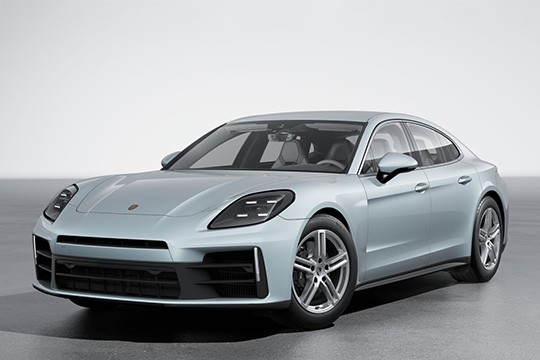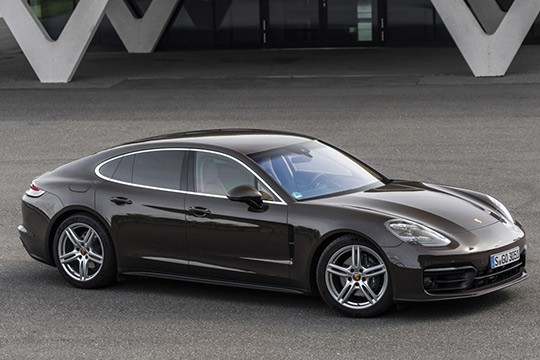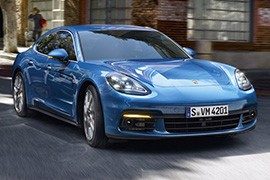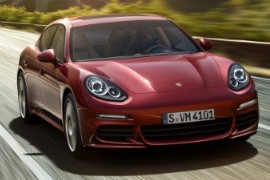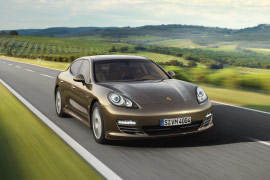PORSCHE Panamera 4 Models/Series Timeline, Specifications & Photos
First production year: 2009
Engines: Gasoline
Porsche unveiled the third generation of the Panamera lineup in late 2023 for the 2024 model year, and, at first sight, it looked more like a facelift than a new model, but it was fresh from the ground up.
One of the most sought-after versions of the Porsche's four-door hatchback was the Panamera 4. It represented an essential piece of the puzzle created by the German automaker when it first introduced the nameplate in its inventory back in 2009. Customers appreciated the safe feeling of driving a potent all-wheel drive, go-fast four-door vehicle and kept asking for it, so Porsche delivered it again in 2016 when it launched the car's second generation. Along with the third sequel of this lineup, the automaker offered it again right from the start, but with significant improvements in terms of power and suspension.
Even if the 2024 Panamera 4 sat on a new platform, its exterior look resembled the previous two generations. The German automaker tried to create a common design language, and it nailed it! Still, that didn't mean it had to use the same parts. As a result, the new headlights sported four LED blocks inside the headlamps, resembling other Porsche models. Lower, on the apron, the automaker created a new broad grille split in three, stretched from side to side, and crossed by two horizontal slats. In addition, a third slim horizontal air intake placed above the bumper increased the cooling area for the engine. A set of additional thin and vertical DRLs marked the outer sides of the bumper.
From its profile, the car kept the same shape as its predecessor. The front fenders sported extracting vents behind the wheel wells to reduce aerodynamic lift. Furthermore, the raked windshield was followed by the arched roof line sloping down towards the car's back. Unfortunately, only a keen eye for detail could distinguish the Panamera 4 from the regular RWD Panamera, and that was possible only from the back, where the automaker placed the Panamera 4 lettering underneath the Porsche name. Furthermore, the rectangular exhausts were similar to those installed in the car's two-wheel drive sibling.
Inside, customers were greeted by a new interior. In front of the driver, the automaker installed a new digital display where the tachometer took center stage, and inside it was the speedometer. It was flanked by additional dials that showed data from the onboard computer. Moving onto the center stack, customers found the touchscreen for the new infotainment system that featured Android Auto and Apple CarPlay. The automaker offered a third screen in front of the side passenger as an option. In the back, the automaker installed two seats separated by a storage area.
Under the hood, Porsche installed a turbocharged 2.9-liter V6 engine paired with an eight-speed automatic gearbox that sent the power in all corners. Like its RWD sibling, the 2024 Panamera 4 had an intelligent adaptive suspension with two chambers per shock absorber to improve speed cornering and comfort.
After four years from the introduction of the Panamera's second generation, Porsche introduced its facelifted version. Some updates were required by new regulations and some for improvement's sake.
In 2013, Porsche started to offer the long-wheelbase version, named Executive, on specific markets with specific engine versions. Since the 2020 model year, it started to offer that option on more markets, and with an option for Sport Tourismo (shooting brake) as well.
For the 2020 model, the Panamera featured a redesigned front fascia, with a different bumper and lower apron. The previously optional Sport Design front end was featured as standard on the facelifted version. In the back, the revamped light strip ran seamlessly over the trunk lid, with an adapted contour and new LED taillights were installed. The three-piece retractable wing was kept.
The interior of the 2020 Panamera 4 featured the already known Porsche Communication Management infotainment system with a 12.3” touch-screen display mounted at the same level as the steering wheel, on top of the center stack. It featured the improved Voice Pilot online voice control and wireless Apple CarPlay. Porsche didn't say anything about the Android Auto connectivity.
Under the hood, the Porsche Panamera 4 featured a twin-turbo V6 engine, good for 330 hp. It was carried-over from the non-facelifted version. The 7-speed PDK (dual-clutch) automatic transmission was fitted as standard.
The second generation of the Panamera started on the right foot, introducing the all-wheel-drive system even on the version with the base engine.
The idea of a 4-door Porsche sedan wasn't new. There were some try-outs in the late '80s with the 989 concept-car that was based on a stretched platform of a 911. But the real deal was shown in 2009 with a front-engine and rear or all-wheel-drive. Its design was not that good, but the car's handling was convincing.
2016 started right with an already established name on the market and the look was way better. The rear end was looking sort of a 911, but better. The designers tried to build a short hood and moved a part of the engine under the windshield area. The headlights were very similar to those on the 911 and the car had great success.
Inside, the touch-screen mania caught well and some buttons from the center console and from the dashboard disappeared. A 12.3" touch-screen infotainment unit found its way onto the dashboard. It was nicely integrated but without an Android Auto connection. The Porsche marketing department said that its users are mostly iPhone users, so they matched it only with Apple CarPlay. The Android phone users had to download a special Porsche app that could work with the unit. The dashboard featured an analog tachometer in the middle, a tribute to the Porsche 356. On the sides, two 7" TFT screens could show various information about the car, bord-computer, navigation, etc.
The Panamera 4 was powered by a turbocharged 2.9-liter V6 paired to a 7-speed PDK (dual-clutch) automatic gearbox. Unlike its sibling, the base Panamera, it sent the power in all four corners. The 330 hp unit offered enough grunt for the luxurious four-door grand tourer.
The 2009 Porsche Panamera base engine version was available exclusively with a rear-wheel-drive system. The 2013 model came to fix that, along with other improvements, on the Panamera 4.
When the first generation of the Panamera was introduced, some details were left aside. It was understandable for a company that never built a four-door sedan in its career, but it is hard to accept some flaws from a project that cost 1 billion Euros. But the 2013 version fixed most of the 2009 model year flaws, including the introduction of the all-wheel-drive base version, the Panamera 4.
A major improvement for the Panamera 4 was the standard bi-xenon headlights and the option for full LED lamps. The daytime running lights were fitted with light-emitting diodes as standard. The revised front and rear bumpers brought a more aggressive look for the car. The bigger side-scoops in the apron were inspired by those installed on the 911 range. A wider rear windscreen was installed on the new tailgate. Despite the high price-tag, the rear wiper was offered as an option.
Inside, the manufacturer installed the PCM (Porsche Communication Management) for the infotainment system. It supported Apple CarPlay connectivity, but its compatibility with Android phones was limited. The tachometer was mounted in the middle of the instrument cluster, with a round TFT display on its right side, where the navigation system could have been shown, as well as other on-board computer information. A bi-color leather interior was offered as an option.
The base engine, installed in the Panamera 4 version, was an upgraded version of the previously used 3.6-liter V6. For the 2013 model year, it was mated exclusively with a 7-speed (PDK – dual-clutch) automatic gearbox and the 6-speed manual was dropped. It also gained some extra horses.
The Panamera 4 was the entry-level all-wheel-drive version for the Panamera, the long-waited four-door Porsche. The German car-maker invested a billion euro in the new project.
At the 2009 Shanghai Auto Show, the German car-maker introduced its newest range: the Panamera range. It was the last piece of the puzzle. After the entry-model Boxster, the well-known 911, and the big SUV Cayenne, Porsche was ready to show its contender in the sport-sedan market. In the beginning, there was only the S, the 4S, and the Turbo versions. The base-model Panamera and Panamera 4 were introduced in 2010.
The Panamera's headlights resembled those installed on the Cayenne. The profile resembled an elongated 911 or the 989 concept-car. On the front fenders, two vents were used to extract the air within the wheel-well and decrease the front-lift effect. In the back, the taillights resembled those found in the Cayman. In the back, on the trunk-lid, a retractable wing was installed. It was automatically extended at speeds over 120 kph (74.5 mph).
Inside, the Panamera 4 designers took their inspiration from the Vertu luxury mobile phones. A four-seat layout was the only option, with a big center console that separated the driver from the other passengers. In the back, there was a decent room for adults and since it was a hatchback it could get an impressive amount of luggage. The dashboard was typical for a Porsche, with round dials and centrally-mounted tachometer.
The entry-level Panamera featured a 3.6-liter V6 engine carried-over from Audi. It was paired as standard to a 6-speed manual. A 7-speed PDK (dual-clutch) was on the options list. The PTM (Porsche Traction Management) was carried-over from other Porsche models. It was based on a multi-clutch center differential system (Haldex).
